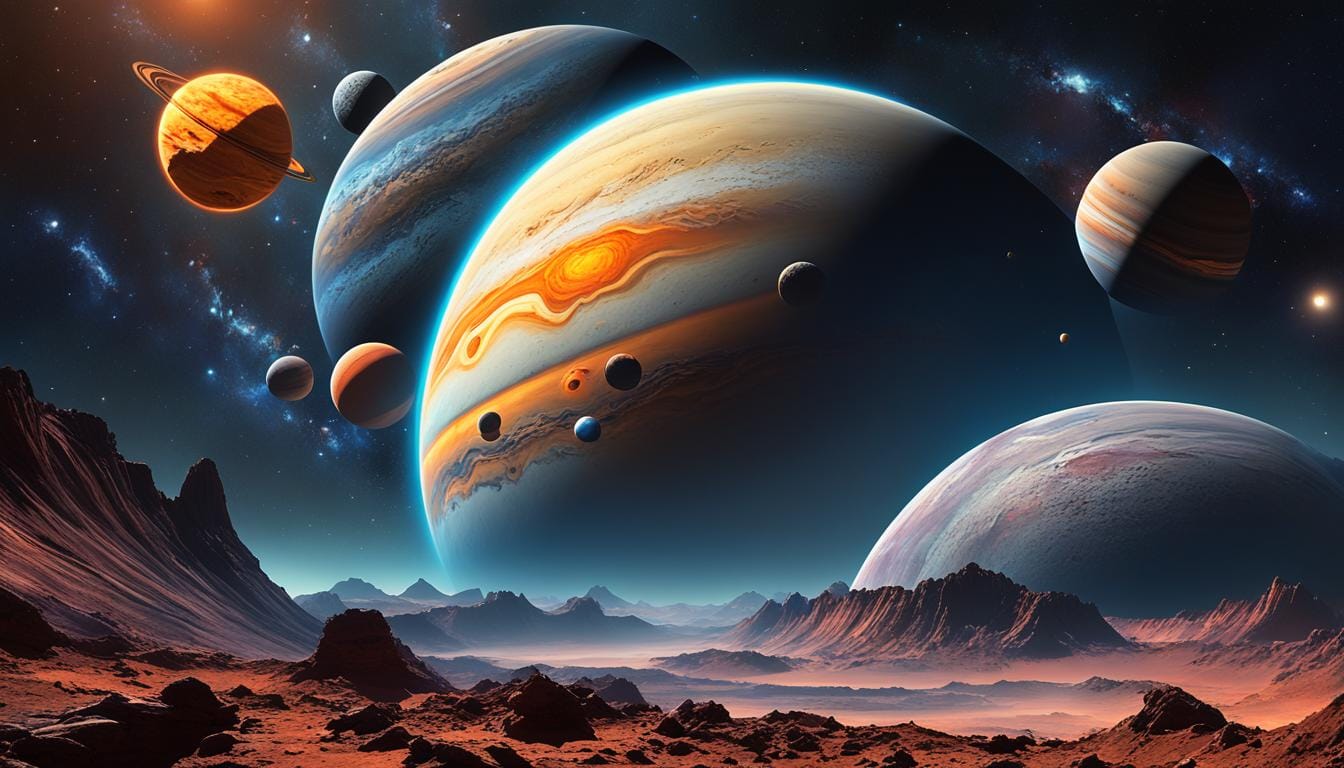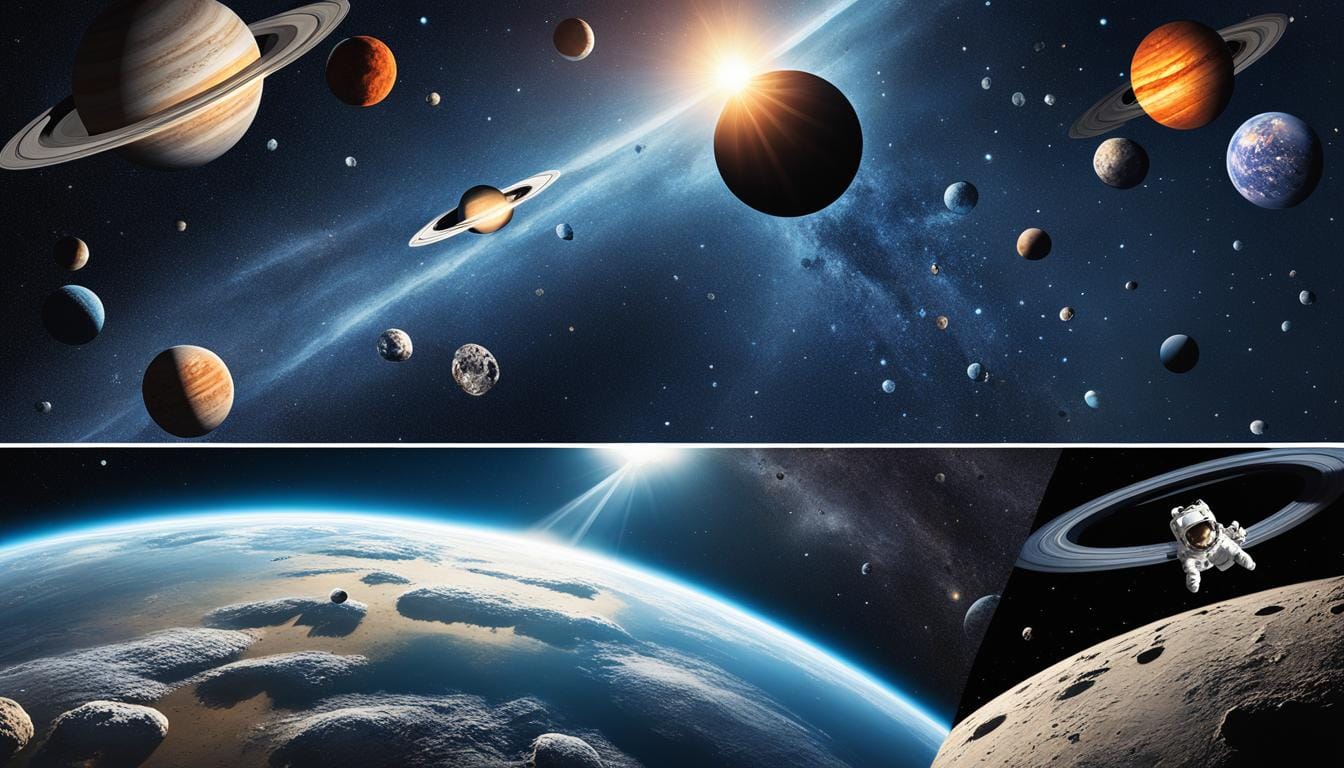The search for alien life has fascinated scientists and the public for many years. It has led to many theories and discoveries. We will look at 10 of the most interesting theories in exobiology and astrobiology.
Scientists have used many methods to search for alien life. They look for signs of life on other planets and study meteorites for clues. With more space exploration, we’ve found more planets that might support life. The Drake equation suggests there could be hundreds of thousands of planets like this in our galaxy.
In 1976, NASA’s Viking Mars landers found something that might be life signs on Mars. But, the results were not clear-cut, causing debate. Later, finding methane gas on Mars made some think there could be life under the surface.
Researchers also look at other places in our solar system for life. They think about life on moons of Jupiter and Saturn, like Europa and Enceladus. The idea of life in these places is very exciting and leads to new research.
The search for alien life is an ongoing and exciting area of science. We will explore 10 key theories in this field next.
Alien Life: The Tantalizing Quest for Extraterrestrial Existence
The search for alien life has fascinated humans for centuries. Most scientists believe life might exist elsewhere in the universe. But, finding intelligent life is still a big question.
Alien life would need to be advanced to contact us. This is a big challenge. The Possibility of Life: Science, Imagination, and Our Quest for Kinship in the Cosmos by Jaime Green talks about how aliens are seen in stories and movies.
The book asks “what if?” about aliens. It shows the power of thinking differently, like how dolphins might help us understand aliens.
Looking for aliens helps us understand our place in the universe. Astronomers think we might find life signs soon. Missions like NASA’s Habitable Worlds Observatory could help a lot.
The panspermia hypothesis and the Fermi paradox spark debate. Finding alien life is a big challenge but also very exciting for scientists and the public.

Finding alien life would change science a lot. It would make us rethink our place in the universe. The search for alien life is a key scientific adventure of our time.
Martian Methane and the Possibility of Microbial Metabolism
The search for alien life has taken a fascinating turn with the discovery of methane on Mars. Methane is a gas that comes from living things on Earth. Finding it on Mars has made scientists think about the chance of life there. In 2004, three groups found methane in the Martian air, making people excited about the idea of life on Mars.
The Puzzling Methane Signatures on the Red Planet
Finding methane on Mars is interesting because it’s made by living things or rocks on Earth. It means there might be a new source of methane, which quickly goes away or leaves the planet. This makes scientists think about life on Mars, maybe in the dirt or underground.
Evaluating the Potential for Life in Mars’ Atmosphere
More proof of life on Mars came when scientists found formaldehyde, a gas made from methane, in 2005. This gas is made when methane is broken down. It shows that there might be life on Mars. Scientists are now studying Mars’ air and chemistry to learn more about this gas.
| Key Findings | Details |
|---|---|
| Viking Labeled Release (LR) Experiment | The 1976 LR experiment on the Viking mission to Mars detected metabolism in Martian soil, potentially indicating the presence of extant microbial life. |
| Methane Detection on Mars | Three independent groups detected methane in the Martian atmosphere in 2004, suggesting a recent source of the gas, which is primarily produced by biological processes on Earth. |
| Formaldehyde Detection | An ESA scientist found evidence of formaldehyde, a byproduct of methane oxidation, in the Martian atmosphere in 2005, further strengthening the case for potential microbial life. |
The search for alien life is getting more exciting with new discoveries on Mars. Finding methane and other gases has made scientists think about life on Mars. They are studying Mars to learn more about these gases and if there could be life there.

The Enigmatic “Wow!” Signal: An Extraterrestrial Transmission?
In 1977, a mysterious event caught the attention of those searching for alien life and extraterrestrial intelligence. On August 15th, the Big Ear Radio Telescope at Ohio State University picked up a strange signal. This signal, known as the “Wow!” signal, is still considered a strong sign of extraterrestrial communication.
The Wow! signal was very interesting. It was in a part of the radio spectrum where no signals are allowed on Earth. Also, it was stronger than most signals from space. The signal’s strength was noted as “6EQUJ5,” showing it was much stronger than usual.
Even with many attempts to find it again, like one by the Breakthrough Listen in 2022, we still don’t know where the Wow! signal came from. Some think it might be a natural event, like a comet with a hydrogen cloud. But the SETI team still wonders if it could be a message from extraterrestrial life.
The Wow! signal has made many people excited and curious. It reminds us of the mystery of finding alien life and extraterrestrial communication. The search for answers keeps going, and this mystery is still a big puzzle in the field of extraterrestrial intelligence.
Fossilized Martian Microbes: The ALH84001 Meteorite Controversy
The search for life beyond Earth took an exciting turn with the ALH84001 meteorite. This Martian rock was in the news in 1996 because NASA scientists thought it might have ancient microbes. This idea has sparked a big debate among scientists. Some believe in fossilized Martian microbes, while others are unsure.
Examining the Evidence for Ancient Life on Mars
The ALH84001 meteorite was found in Antarctica in 1984. It likely came from Mars when the planet had water, which is key for life. NASA scientists found some interesting things in the rock that made them think of fossilized microbes, including:
- Polycyclic aromatic hydrocarbons (PAHs) – These are organic compounds that could come from microbes.
- Magnetite crystals – These minerals are like those made by some bacteria on Earth.
- Carbonate globules – These might have been made by ancient Martian microbes.
Debunking the Claims: Contaminants or Martian Fossils?
Not everyone agrees with the findings. Some scientists think the organic stuff and minerals in the ALH84001 came from non-biological processes on Mars, not from life. They also question if the “microfossils” could really be alive.
Research is ongoing to understand the ALH84001 meteorite better. Finding proof of life elsewhere is hard, but this rock keeps scientists and the public interested. It makes us wonder if there’s life out there.
Alien Life: Reassessing the Drake Equation’s Implications
The search for alien life has always fascinated scientists and the public. The famous Drake equation, created by Frank Drake in 1961, is key to this search. It tries to figure out how many planets in our galaxy might have intelligent life. The debate over its factors has changed our understanding of the possibility of life elsewhere.
Drake first thought there could be about 10,000 planets with life in the Milky Way. Later, with new info, this number changed. By 2001, experts thought there could be hundreds of thousands of life-bearing planets, some maybe just a few hundred light-years away.
Now, scientists are looking closer at the math behind the Drake equation. They found it’s very unlikely we’re the only smart life in the Milky Way. The chances are less than one in 10 billion trillion. But, if a planet can support life and it’s likely to happen, then another smart species might be out there.
About one-fifth of stars might have planets that could support life. With over 100 billion stars in the Milky Way, the chance of finding life is strong. This makes the idea of meeting aliens more believable.
The Drake equation has been crucial in understanding life and intelligence in the universe. As we learn more, its implications keep changing. It helps guide our search for alien life and how we might talk to them.
The hunt for alien life, extraterrestrial intelligence, exobiology, and astrobiology is a big deal in science. With SETI and new insights into the Drake equation and habitable planets, finding galactic civilizations seems more possible.
Europa’s Frozen Bacteria: A Potential Explanation for Its Peculiarities
The moon Europa, orbiting Jupiter, has always been a mystery to scientists. In 2001, NASA scientists had a new idea. They thought the red color and strange infrared signals from Europa might come from frozen bacteria.
The Red Tinge and Infrared Anomaly: Clues to Life?
Researchers found that some Earth bacteria, living in harsh places, match Europa’s infrared signals well. These bacteria’s reddish color could explain Europa’s own red look. They might live in Europa’s warm liquid center and get frozen on the surface.
This idea is interesting because Europa might have conditions that support life under its ice. It has a big ocean beneath its ice and shows signs of activity that could mean hydrothermal vents. These vents are great places for life to exist.
The search for alien life on Europa is ongoing, and this theory could be right. As we learn more about extraterrestrial intelligence and exobiology, Europa’s icy surface might reveal secrets. It could show us how frozen bacteria can survive in our solar system’s harsh places.
The Venusian Cloud Conundrum: A Haven for Microbial Life?
The search for life beyond Earth has always fascinated scientists. One interesting idea is that life might exist in Venus’ clouds. In 2002, scientists from the University of Texas thought about this. They found strange things in Venus’ air that could mean microbes live in its clouds.
They found things like carbon monoxide and hydrogen sulfide in Venus’ air. These things don’t just happen by themselves. The scientists thought maybe microbes in the clouds could be the reason for these gases.
Exploring the Atmospheric Mysteries of Venus
In 2020, finding phosphine in Venus’ air made the idea of life there more exciting. Phosphine is rare on Earth and can come from living things in places without oxygen.
This phosphine in Venus’ clouds was a lot more than expected from natural causes. It made people think about the chance of life in the upper clouds of Venus. These clouds are cooler and less harsh than the hot surface.
But, life in Venus’ clouds would be tough because of the sulfuric acid there. How life could survive there is still a big question for scientists.
With new missions like NASA’s Perseverance Rover going to Mars, we might learn more about Venus too. Finding life in Venus’ clouds would change how we see life in the universe.
Sulphur Traces on Europa: Waste Products of Underground Colonies?
In 2003, Italian scientists thought they found signs of alien life on Jupiter’s moon Europa. They saw sulphur on its surface, like waste from bacteria under Antarctica’s ice. They believed these bacteria might live in Europa’s ocean under the ice, with sulphur trapped in the ice above.
But, others think the sulphur could come from the moon Io, which has lots of it. Europa has a huge amount of water, maybe even more than Earth’s oceans. This makes it a great place to look for extraterrestrial intelligence and exobiology.
The Galileo spacecraft flew close to Europa 12 times and found a big ocean under its ice. This ocean is salty and has enough heat to support life, thanks to Jupiter’s gravity. This heat could mean there’s life under the ice.
Life on Europa might get energy from chemicals, not sunlight. This is because there’s no sunlight under the ice. Instead, life could use energy from reactions that involve oxygen made by radiation in Europa’s thin atmosphere.
| Key Facts | Details |
|---|---|
| Sulphur Traces on Europa | Detected by the Galileo space probe, similar to waste products of Antarctic bacteria |
| Subsurface Ocean on Europa | Estimated to have twice the water of Earth’s oceans, maintained by tidal flexing |
| Potential for Microbial Life | Chemical energy from water-splitting reactions, rather than photosynthesis |
The Resilient Deinococcus radiourans: A Martian Origin?
The hunt for alien life and extraterrestrial intelligence has always fascinated scientists and the public. A theory that caught attention is the idea that the tough bacterium, Deinococcus radiourans, might come from Mars.
Investigating the Extreme Radiation Resistance of Deinococcus
In 2002, Russian astrobiologists made a big statement. They said that Deinococcus radiourans‘s ability to handle lots of radiation might have come from living on Mars. This bacterium can take doses of up to 5,000 grays (Gy) of radiation, which would be deadly for humans. They thought this could only happen on Mars, where there’s no shield against radiation like on Earth.
The scientists figured it would take thousands of times of getting hit with radiation to get this tough on Earth. They said it would take much longer than the 3.8 billion years life has been on our planet. They think Deinococcus‘s ancestors came from Mars on a meteorite, bringing this amazing exobiology to our world.
More studies have shown just how tough Deinococcus radiourans is. It can handle over 200 times the radiation we get on Earth. It even survived in space for up to three years. Its DNA repair skills and use of manganese to fight off damage are key to its astrobiology success.
The idea that Deinococcus radiourans might have come from Mars is still just a theory. But its amazing traits keep scientists interested and push the search for alien life forward.
Extraterrestrial Signals and the Search for Technological Intelligence
The search for alien life and signals from other worlds has been a big deal for scientists for many years. Since the 1960s, scientists have been using radio telescopes to look for signals from other civilizations. But finding signals from so far away is really hard because of the vast distances and many ways to communicate.
In 2020, a strange beam of energy was found coming from Proxima Centauri, the closest star to our sun. This made people very interested in finding signs of life outside Earth again. The source of this signal is still being checked, but it shows we’re still looking hard for signs of intelligent life out there.
Deciphering the Mysteries of Cosmic Radio Bursts
Looking for alien signals has changed a lot over time. Scientists are now trying different ways to find signs of technology from other worlds. One interesting thing they’re looking at is cosmic radio bursts. These are short, strong flashes of radio energy from far away in space.
These cosmic radio bursts were first found in 2007 and have been studied a lot since then. They might be signs of advanced alien life. Scientists are trying to figure out what these signals mean and where they come from. They could be messages from aliens or just really cool technology.
Looking for alien signals and understanding their technology is still a big deal in science. As we learn more about the universe and find more planets that might support life, scientists are hopeful. They think they might soon make a big discovery that could tell us if we’re not alone in the universe.
Conclusion: Unraveling the Enigma of Alien Life
The search for alien life keeps scientists and the public interested with new findings and theories. Signs of life on Mars and Venus, and possibly in our galaxy’s oceans, suggest that extraterrestrial organisms might exist. But finding proof of alien life is hard because of the vast distances and different places in space.
As we learn more about life on Earth, we keep looking for alien life. This search is pushing what we know and imagine. Thanks to space exploration, exobiology, and astrobiology, we’ve made big discoveries and created new tech, like the SETI program. But finding clear proof of extraterrestrial life is still tough, showing how complex and big the universe is.
Our desire to know more and explore the unknown keeps driving science to solve the universe’s mysteries. As we reach for the stars, finding alien life is a key goal. It could change how we see our place in the universe.


